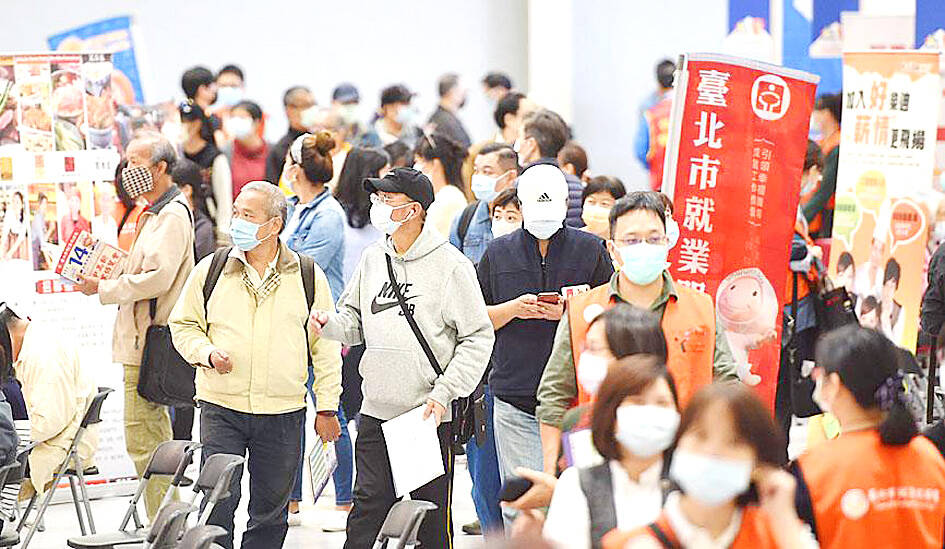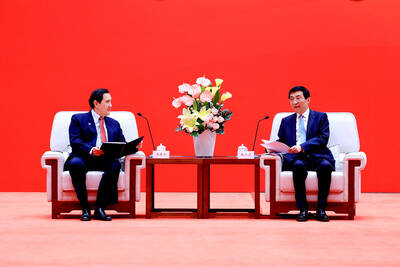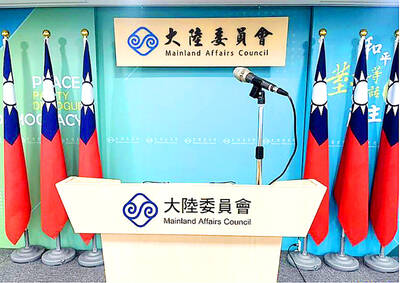Taiwan’s working-age population is expected to shrink by 200,000 people annually due to a falling birthrate and the retirement of people born in the 1960s and 1970s, National Development Council (NDC) data showed.
The working-age population — people aged 15 to 64 — would fall from 16.17 million people (69.1 percent of the population) last year to 13.17 million people (60.9 percent) in 2040, and to 10.6 million people (50.8 percent) in 2050.
That means the working-age population would decrease by about 5 million people from last year to 2050, an annual decrease of about 200,000.

Photo: Liu Hsin-de, Taipei Times
The figure is projected to drop to 6.97 million people, or 46.6 percent, in 2070.
People aged 45 to 64 accounted for 44.8 percent of the working-age population last year and would increase to 53 percent in 2070, meaning more than half of the working-age population would be middle-aged and elderly.
The nation’s population would drop to fewer than 20 million by 2049 with the median age being 57.
The average life expectancy in Taiwan would surpass 85 years by 2050 — 82 years for men and 88.2 years for women — with the number of people aged 65 or older reaching a record high of 7.57 million, or 38.4 percent of the population.
However, the size and percentage of the future working-age population would be smaller, as the above estimates were made on the premise that the birthrate would rise to 1 child per woman, the NDC said.
Taiwan’s birthrate fell to fewer than 2.1 children per woman — the sub-replacement threshold — in 1984 and fewer than 1.5 children per woman in 2001.
It declined to fewer than 1 child per woman in 2020 and continued to fall to 0.87 in 2023 and 0.86 last year.
Using a lower birthrate of 0.8 children per woman for estimates could give more realistic projections, the NDC said.
Meanwhile, the nation’s elderly population has increased to about 4.5 million people last year from 3 million in 2016, an increase of up to 50 percent, data showed.
However, in the same period the labor force participation rate for people aged 65 increased by only 1.3 percent to 9.91 percent last year from 8.61 percent in 2016. That is far lower than Singapore’s and South Korea’s more than 30 percent, and Japan’s 25 percent.
The labor force participation rate for people aged 45 to 64 increased to 67.21 percent from 62.42 percent over the same period.
An official, speaking on condition of anonymity, yesterday said that the labor force participation rate is difficult to boost, as the number of elderly people is rapidly increasing.
It rose to about 4.45 million people last year from about 4.26 million people in 2023, up by 192,000 people, while the labor force increased by only 16,000 people, they said.
Since the Middle-aged and Elderly Employment Promotion Act (中高齡者及高齡者就業促進法) entered into force in 2020, the participation rate of middle-aged and elderly people in the job market has significantly increased, but the figure for people aged 65 and older still needs improvement, the official said.
As Taiwan this year became a “super-aged society” and faces labor shortages in many industries, the Ministry of Labor would do its best to boost the labor force participation rate, they said.
The ministry aims to help 120,000 middle-aged or elderly people get employed every year, with their participation rate reaching 70 percent by 2028, they said.

BUILDUP: US General Dan Caine said Chinese military maneuvers are not routine exercises, but instead are ‘rehearsals for a forced unification’ with Taiwan China poses an increasingly aggressive threat to the US and deterring Beijing is the Pentagon’s top regional priority amid its rapid military buildup and invasion drills near Taiwan, US Secretary of Defense Pete Hegseth said on Tuesday. “Our pacing threat is communist China,” Hegseth told the US House of Representatives Appropriations Subcommittee on Defense during an oversight hearing with US General Dan Caine, chairman of the Joint Chiefs of Staff. “Beijing is preparing for war in the Indo-Pacific as part of its broader strategy to dominate that region and then the world,” Hegseth said, adding that if it succeeds, it could derail

CHIP WAR: The new restrictions are expected to cut off China’s access to Taiwan’s technologies, materials and equipment essential to building AI semiconductors Taiwan has blacklisted Huawei Technologies Co (華為) and Semiconductor Manufacturing International Corp (SMIC, 中芯), dealing another major blow to the two companies spearheading China’s efforts to develop cutting-edge artificial intelligence (AI) chip technologies. The Ministry of Economic Affairs’ International Trade Administration has included Huawei, SMIC and several of their subsidiaries in an update of its so-called strategic high-tech commodities entity list, the latest version on its Web site showed on Saturday. It did not publicly announce the change. Other entities on the list include organizations such as the Taliban and al-Qaeda, as well as companies in China, Iran and elsewhere. Local companies need

CRITICISM: It is generally accepted that the Straits Forum is a CCP ‘united front’ platform, and anyone attending should maintain Taiwan’s dignity, the council said The Mainland Affairs Council (MAC) yesterday said it deeply regrets that former president Ma Ying-jeou (馬英九) echoed the Chinese Communist Party’s (CCP) “one China” principle and “united front” tactics by telling the Straits Forum that Taiwanese yearn for both sides of the Taiwan Strait to move toward “peace” and “integration.” The 17th annual Straits Forum yesterday opened in Xiamen, China, and while the Chinese Nationalist Party’s (KMT) local government heads were absent for the first time in 17 years, Ma attended the forum as “former KMT chairperson” and met with Chinese People’s Political Consultative Conference Chairman Wang Huning (王滬寧). Wang

CROSS-STRAIT: The MAC said it barred the Chinese officials from attending an event, because they failed to provide guarantees that Taiwan would be treated with respect The Mainland Affairs Council (MAC) on Friday night defended its decision to bar Chinese officials and tourism representatives from attending a tourism event in Taipei next month, citing the unsafe conditions for Taiwanese in China. The Taipei International Summer Travel Expo, organized by the Taiwan Tourism Exchange Association, is to run from July 18 to 21. China’s Taiwan Affairs Office spokeswoman Zhu Fenglian (朱鳳蓮) on Friday said that representatives from China’s travel industry were excluded from the expo. The Democratic Progressive Party government is obstructing cross-strait tourism exchange in a vain attempt to ignore the mainstream support for peaceful development